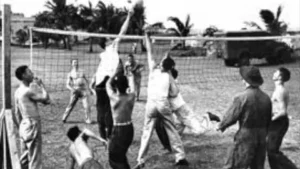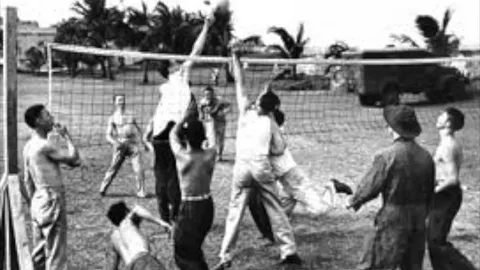History of Volleyball: From Beaches to the Olympic Arena ?

Introduction to Volleyball’s Journey
Volleyball has come a long way since its early days as a low-impact alternative to basketball. Today, it’s a high-energy sport that commands an international audience, both indoors and on sandy beaches. The history of volleyball: from beaches to the Olympic arena showcases how the sport has grown from a recreational game to an Olympic-level event, attracting some of the world’s top athletes. Let’s dive into the fascinating journey of this global favorite!
The Humble Beginnings of Volleyball
Volleyball originated in 1895, thanks to William G. Morgan, a YMCA physical education director in Massachusetts. Morgan’s idea was to create a sport that offered a less physically demanding alternative to basketball, which had been invented just four years earlier. Originally named “Mintonette,” volleyball was designed to blend aspects of tennis, handball, and baseball, making it accessible to a wide range of players.
Early Rules and Adaptations
The first set of volleyball rules outlined a few basic principles, such as the objective of keeping the ball in motion over a net. Initially, players could have as many as nine on each side, and the game didn’t involve the now-familiar three-hit limit. As interest grew, adjustments were made to improve gameplay, eventually leading to the standard six-player team and three-touch rule seen today.
Growth of Indoor Volleyball
Indoor volleyball quickly gained popularity across the United States, especially within YMCA networks and schools. The game spread internationally by the early 20th century, with Canada being the first country outside the U.S. to adopt it. Through the work of YMCA missionaries, volleyball made its way to Asia, Europe, and South America, laying the groundwork for the global volleyball community we know today.
Rise of Beach Volleyball
While indoor volleyball was gaining traction, beach volleyball was quietly emerging on the sands of California in the 1920s. The beach version brought a relaxed, sun-soaked vibe that attracted casual players and spectators alike. Played with just two players per team, beach volleyball allowed for greater individual athleticism and highlighted the skill and agility of each player.
Beach Volleyball Goes Mainstream
Beach volleyball started to gain global attention by the 1970s and 80s, thanks to the rise of professional tournaments in the U.S. and Europe. Events like the Manhattan Beach Open helped solidify beach volleyball’s image as an exciting, competitive sport. Players like Sinjin Smith and Karch Kiraly became household names, contributing to the sport’s surging popularity.
Volleyball’s Road to the Olympics
The journey of volleyball from beaches to the Olympic arena took several decades. Indoor volleyball was officially introduced to the Olympics in 1964 at the Tokyo Games, with the support of the Fédération Internationale de Volleyball (FIVB). This inclusion marked a major milestone, showcasing volleyball as a respected and widely recognized sport on an international level.
Introduction of Beach Volleyball to the Olympic Games
Following indoor volleyball’s Olympic success, beach volleyball made its debut at the 1996 Atlanta Olympics. The event brought a fresh, dynamic edge to the Games, with teams competing on sand rather than hardwood floors. The differences between indoor and beach volleyball—from team size to game format—added variety to the Olympic program and attracted new fans to the sport.
Notable Olympic Moments in Volleyball
Throughout its Olympic history, volleyball has witnessed thrilling matches and legendary performances. Key moments include the Soviet Union’s dominance in the early years, Brazil’s rise as a volleyball powerhouse, and Kerri Walsh Jennings and Misty May-Treanor’s gold-winning streak in beach volleyball. These events continue to inspire future generations, highlighting volleyball’s resilience and excitement on the global stage.
Volleyball Around the World
Today, volleyball is played and loved across continents, each bringing its own flair to the sport. In Brazil, volleyball is a national passion, and in Japan, players are known for their precision and teamwork. Meanwhile, European nations have developed strong leagues and fan bases, with Italy and Russia being prominent players on the world stage.
The Role of FIVB (Fédération Internationale de Volleyball)
Founded in 1947, the FIVB has been instrumental in standardizing and promoting volleyball worldwide. This governing body organizes the Volleyball World Championship, the World Cup, and various league events, ensuring consistent rules and regulations while encouraging fair play. The FIVB has been essential in establishing volleyball as a top-tier sport.
Evolution of Volleyball Techniques and Strategies
Volleyball has evolved beyond simple net-passing to include a range of advanced techniques and tactics. The spike, the block, and the jump serve are just a few of the moves that have made the game faster and more exciting. Defensive strategies have also advanced, with specialized positions like libero introduced to maximize team coordination.
Modern Day Volleyball: Indoor vs. Beach
Indoor and beach volleyball may share a name, but the two variations are unique in gameplay and culture. Indoor volleyball is a fast-paced, team-centric game with a larger court and six players per side, whereas beach volleyball’s two-player format and smaller sand court encourage greater individual involvement. Both versions have their own set of fans, each passionate about the skill and athleticism of the players.
Volleyball in Pop Culture and Media
Volleyball’s popularity has extended beyond the court, making appearances in movies, books, and television shows. Films like Top Gun famously showcased beach volleyball, while anime series like Haikyuu!! have introduced a new generation to the thrills of indoor volleyball. This cultural presence keeps volleyball relevant, helping to attract a global fanbase.
Future of Volleyball: Trends and Innovations
With the rise of technology and sports analytics, volleyball is evolving yet again. Innovations like real-time performance tracking and virtual training tools are enhancing players’ abilities and strategies. Looking ahead, the history of volleyball: from beaches to the Olympic arena will likely include even more thrilling developments, drawing in fans and athletes from all corners of the globe.
FAQs
Who invented volleyball, and why?
Volleyball was invented by William G. Morgan in 1895 as a less intense alternative to basketball, suitable for people of all ages and skill levels.
What are the key differences between indoor and beach volleyball?
Indoor volleyball has six players per side on a larger court, while beach volleyball has two players per team on a smaller sand court. Beach volleyball is also influenced by weather conditions, adding a unique challenge.
When did volleyball become an Olympic sport?
Indoor volleyball debuted in the Olympics in 1964, while beach volleyball joined the Olympic lineup in 1996.
How has the popularity of beach volleyball grown?
Beach volleyball grew in popularity due to its casual, beach-friendly vibe and gained worldwide attention through professional tournaments and Olympic inclusion.
What role does the FIVB play in global volleyball development?
The FIVB standardizes rules, organizes global competitions, and promotes volleyball internationally, supporting the sport’s growth and development on a global scale.
Conclusion
Volleyball has traveled an incredible journey, from a YMCA gymnasium to Olympic stadiums, with stops on beaches around the world. Its transformation from a casual game to a celebrated global sport reflects the dedication and passion of athletes, fans, and organizations alike. Whether played on sand or hardwood, volleyball continues to inspire, challenge, and unite people worldwide.
